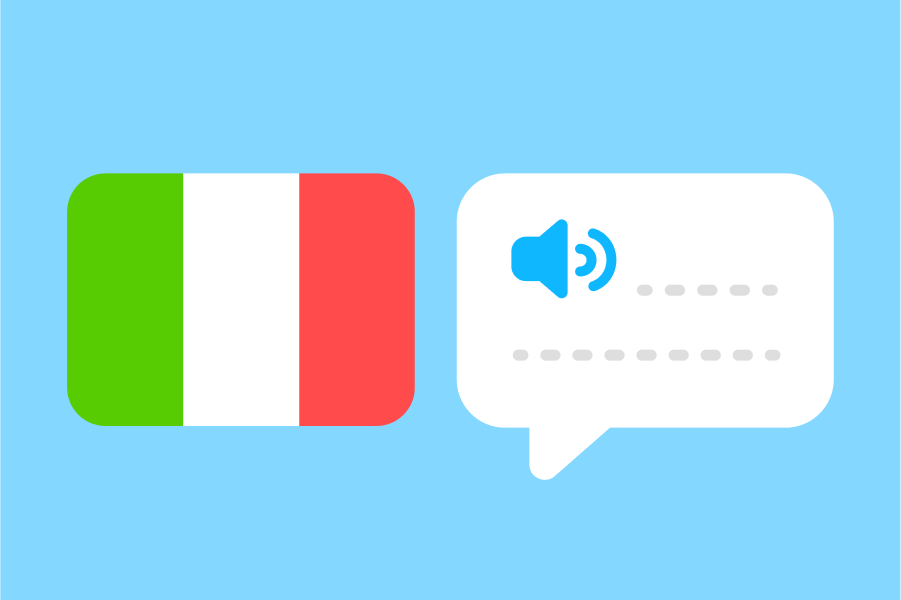When you’re learning a new language, it can be hard to tell how to pronounce different letter combinations and sounds. Fortunately, learning to read Italian is a lot more straightforward than learning to spell in English! In Italian, how letters are pronounced tends to be consistent, so once you understand the basics of Italian writing, you’ll be well on your way to knowing how to pronounce any Italian word.
Use this pronunciation guide for standard Italian together with general pronunciation tips to improve your speaking skills!
In this post:
How to pronounce Italian vowels
Each written vowel in Italian has only 1 or 2 possible pronunciations:
| Letter | Sound (IPA) | Examples |
|---|---|---|
| a | /a/ | cane (dog) caro (expensive) |
| e | /e/ | cena (dinner) mela (apple) |
| e | /ɛ/ | bello (beautiful) senza (without) |
| i | /i/ | tipo (kind) di (of) |
| o | /o/ | sono (am) voce (voice) |
| o | /ɔ/ | rosa (pink) cosa (thing) |
| u | /u/ | scusa (excuse me) duro (hard) |
Italian also combines those basic vowel sounds in the following ways:
| Letters | Sound (IPA) | Examples |
|---|---|---|
| ai | /aj/ | mai (never) dai (you give) |
| au | /aw/ | aurora (dawn) causo (I cause) |
| ei | /ej/ | dei (of the) nei (in the) |
| ei | /ɛj/ | sei (six) lei (she) |
| eu | /ew/ | pneumatico (tire) europeo (European) |
| eu | /ɛw/ | euro (euro) |
| iao | /jao/ | miao (meow) |
| ia | /ja/ | iato (hiatus) siamo (we are) |
| ie | /jɛ/ | ieri (yesterday) miele (honey) |
| iei | /jɛj/ | miei (my) |
| io | /jo/ | fiore (flower) violino (violin) |
| io | /jɔ/ | piove (it’s raining) pioggia (rain) |
| iu | /ju/ | aiuto (help) piuma (feather) |
| oi | /oj/ | noi (we) voi (you all) |
| oi | /ɔj/ | poi (then) |
| ua | /wa/ | uguale (same) quadro (picture) |
| uai | /waj/ | guai (troubles) |
| ue | /we/ | questo (this) quello (that) |
| ue | /wɛ/ | quercia (oak) guerra (war) |
| ui | /wi/ | qui (here) quindi (so) |
| uo | /wo/ | nuotare (to swim) suonare (to play) |
| uo | /wɔ/ | cuore (heart) uovo (egg) |
| uoi | /wɔi/ | puoi (you can) vuoi (you want) |
How to pronounce Italian consonants
Many Italian consonants make the same sounds as English, but here are some important differences:
| Letters | Sound (IPA) | Examples |
|---|---|---|
| c + e c + i |
/tʃ/ | certo (of course) cielo (sky) |
| c + all other vowels | /k/ | casa (house) come (as) |
| ch | /k/ | che (what) chiedo (I ask) |
| g + e g + i |
/dʒ/ | gelato (ice cream) giorno (day) |
| g + all other vowels | /g/ | gonna (skirt) gusto (taste) |
| gh | /g/ | leghe (leagues) ghiro (dormouse) |
| gl + i | /ʎ/ (make a “y” sound, then pull the middle of your tongue up to the back of your mouth for a sort of “ly” sound) | gli (the) famiglia (family) |
| gl + all other vowels | /gl/ | glutine (gluten) globo (globe) |
| gn | /ɲ/ (like “ni” in “onion”) | ogni (every) lavagna (chalkboard) |
| h | (Nothing… it’s silent!) | hotel (hotel) |
| sc + e sc + i |
/ʃ/ | pesce (fish) scimmia (monkey) |
| sc + all other sounds | /sk/ | scuola (school) scattola (box) scrivere (to write) |
| sv | /zv/ | svago (hobby) |
| pn | /pn/ (say both letters) | pneumatico (tire) |
| ps | /ps/ (say both letters) | psicologia (psychology) |
Double consonants in Italian
Italian has many geminates, or double consonants. Whenever you see a double consonant, you need to hold it longer than a single one. For example, sete (thirst) has a shorter “t” sound, while sette (seven) will be pronounced more like set + te, with the “t” being pronounced for longer (and the first “e” for shorter!).
Accent marks in Italian
Accent marks are not used that often in Italian. Occasionally they are used to show the difference between two words that are spelled the same way, such as e (and) and è (is). Otherwise, the accent mark tells you that the last part of the word is stressed (or emphasized). For example, in città (city), the stress goes at the end.
You can say that again!
Now that you know the basics of Italian pronunciation, you’ll be able to read any word and know how to say it. With practice, sounds that don’t exist in English will become second nature to you, and you’ll be speaking Italian with confidence!
